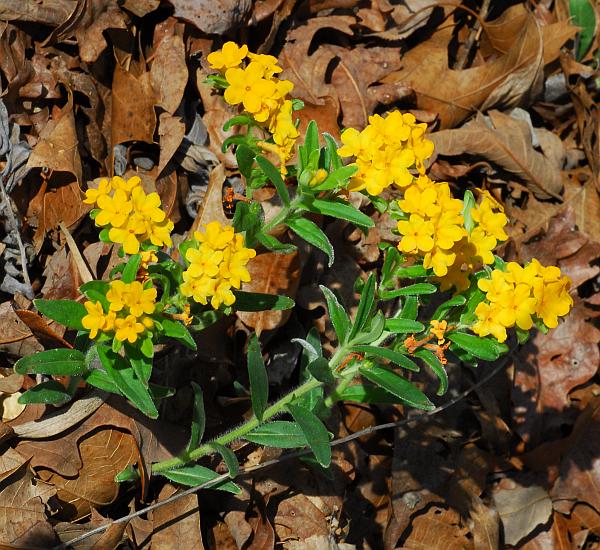Lithospermum canescens (Michx.) Lehm.
Hoary Puccoon

Native
CC = 6
CW = 5
MOC = 81
© SRTurner
Lithospermum canescens (Michx.) Lehm.Hoary Puccoon | |
 |
Native CC = 6 CW = 5 MOC = 81 |
© SRTurner |
|
Family - Boraginaceae Habit - Perennial forb with rhizomes or a short, woody rootstock. Stems - Ascending to erect, to 40, solitary to several, unbranched or sparsely branched toward the tip, densely pubescent with loosely ascending to spreading, soft, slender, mostly nonpustular-based hairs.
Leaves - Alternate, simple, entire, sessile. Blades 1-5 cm long, 3-12 mm wide, narrowly oblong to lanceolate, relatively thick, angled to narrowly rounded at the base, rounded or angled to a usually bluntly pointed tip, sometimes with an abrupt, minute, sharply pointed tip, the surfaces densely pubescent with short, loosely ascending, sometimes minutely pustular-based hairs, grayish green, without noticeable lateral veins.
Inflorescence - Dense terminal clusters, these subsequently elongating into ascending, scorpioid, spikelike racemes 3-10 cm long. Pedicels to 1.5 mm.
Flowers - Plants distylous. Calyces 3-6 mm long at flowering, elongating to 6-9 mm at fruiting. Corolla salverform, 12-18 mm long, broadly funnelform, yellow to orange, the tube 7-10 mm long, the lobes 3-6 mm long, pubescent externally, glabrous internally, 5-lobed, entire. Expanded portion of corolla 1.0-1.5 cm broad, 1.2 cm long. Tube of corolla 7 mm long, 2.5 mm in diameter. Stamens 5, attached just below the midpoint of the corolla tube in long-styled flowers, just above the midpoint in short-styled flowers. Style 5-9 mm long in long-styled flowers, 1-2 mm long in short-styled flowers. Ovary 4-parted, glabrous. Style 1, 5-10 mm long, sometimes weakly exserted. Cleistogamous flowers not produced.
Fruits - Nutlets 2.5-3.0 mm long, the tip more or less symmetrical, usually with a short, scoop-shaped appendage at the attachment point, hard and shiny, smooth, yellowish white to pale yellowish brown.
Flowering - March - June. Habitat - Glades, savannas, prairies, ledges and tops of bluffs, upland forest openings, pastures, railroads, roadsides, and open, disturbed areas. Origin - Native to the U.S. Lookalikes - L. caroliniense. Other info. - The rich, bright colors of the flowers on this plant more than compensate for its small stature. The plant is common throughout the upper Midwest, somewhat less so in the eastern U.S. and into Canada. The highly saturated yellow-orange color of the flowers is distinctive; however, the plant can be confused with L. caroliniense. That species is somewhat larger and more robust, and has slightly larger flowers and leaf hairs which are stiffer and pustular-based. Photographs taken off Hwy 106, Shannon County, MO., 5-23-03, and at Danville Conservation Area, Montgomery County, MO., 3-30-04 (DETenaglia); also at Washington State Park, Washington County, MO, 4-21-2014, Little Lost Creek Conservation Area, Warren County, MO, 4-15-2017, and St. Joe State Park, St. Francois County, MO, 5-5-2025 (SRTurner). |